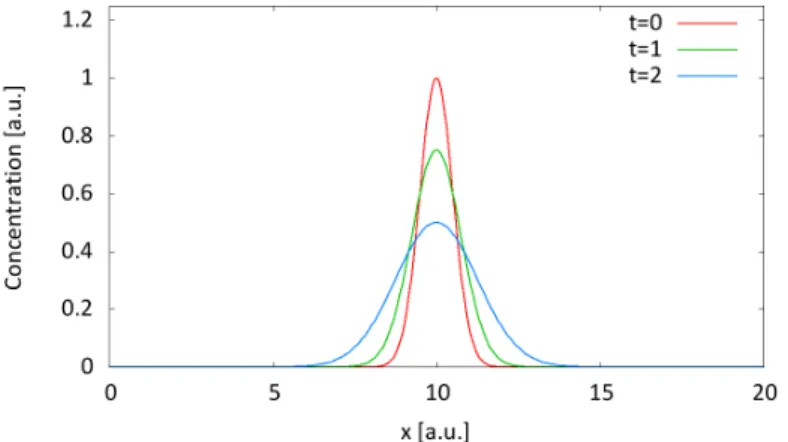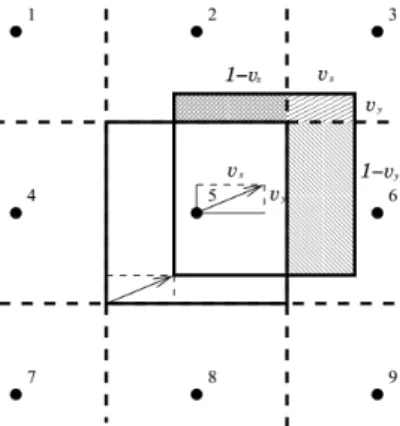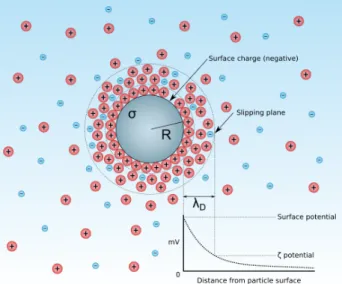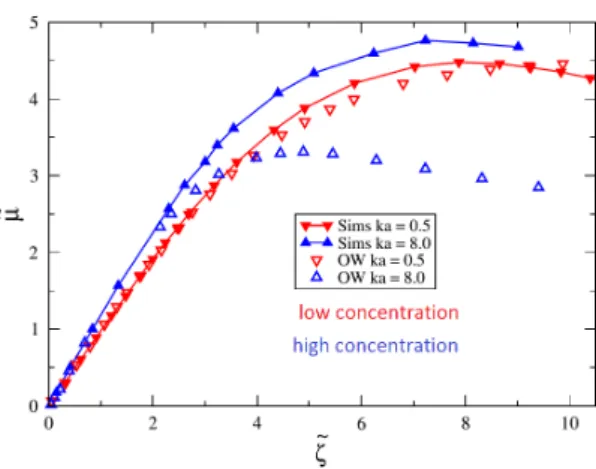An electrokinetic LB based model for ion transport and macromolecular electrophoresis
Raffael Pecoroni Supervisor: Michael Kuron
July 8, 2016
1 Introduction & Motivation
So far an mesoscopic coarse-grained model for DNA transport through nanopores has been discussed. But we have taken no account of the solvent in that the DNA has been suspended. Additionally the solvent usually contain charged solutes due to dissociation of molecules at boundary surfaces or simply by autoprotolysis of water.
Thus we will have a closer look on electrolytes and its behaviour in motion. We will derive the underlying equations and furthermore solve them.
2 Electrokinetic Equations
The dynamics of charged solutes in a fluid is described by the electrokinetic equations which form a coupled nonlinear system of differential equations. One must take into account
• hydrodynamics of the solvent,
• the solute dynamics and
• electrostatics (ionic solutes or charged boundaries).
In the following this equation system is derived.
2.1 Hydrodynamics
We assume an incompressible fluid, so the velocity field is free of divergence which gives us the restriction
∇ · ~ u = 0 . (1)
The dynamics of the solvent is specified by the Navier-Stokes-Equation (NSE) which provides momentum conser- vation and takes then the following form [4]
ρ ∂
∂t ~ u + ρ~ u · ∇~ u = η∇ 2 ~ u − ∇p + f ~ ext . (2)
ρ(~ r) is here the density of the solvent, ~ u(~ r) the velocity field at each point, η the dynamic viscosity, p the hydrostatic
pressure, and f ~ ext is the external force. In our case moving solutes interact with the fluid and therefore cause a
momentum transfer. So this external force term couples the solvent to the solute behaviour. Both equations
describe hydrodynamics entirely so we can dedicate ourselves to the solute dynamics.
2.2 Dynamics of solute species
Conservation of mass is stated by the continuity conservation law with the density of species ρ k (~ r, t)
∂
∂t ρ k + ∇~j k = 0 . (3)
Each species k has to be treated on its own if there are more than one solute species suspended in a fluid.
Two different phenomena contribute to the transport flux of species in a solvent: diffusion and advection (~j k =
~j k diff + ~j k adv ). We will consider them separately deriving the equations and eventually merge them.
2.2.1 Diffusion
A varying concentration of the solute in a solvent leads to a flux from regions of higher concentration towards regions lower concentration like depicted in figure 1.
Figure 1: Diffusive behaviour of a gaussian distributed concentration plotting different points in time. The maximum decreases as the concentration distribution broadens. The integral under the curve keeps constant that implies mass conservation.
The diffusive term is determined by Fick’s law [3, 4]
~j k diff = −D k ∇ρ k (4)
with the diffusion coefficient D k that describes how fast the solute spreads. If the species are charged or an electric field E = −∇φ exists, Fick’s law is extended by a term depending on the ratio of electric potential and thermal energy
~j diff k = −D k ∇ρ k − D k z k e k B T ρ k ∇φ
| {z }
due to electric field
(5)
with the valency z k of the k-th species.
2.3 Advection
Solute species are also moving due to the fluid flow ~ u that has to be obtained from NSE. This phenomena is called advection and is displayed in figure 2. In contrast to diffusion the concentration moves here in space but does not broaden. The flux is defined by
~j k adv = ~ uρ k . (6)
Inserting both diffusive flux and advective flux into equation (3) we result in Poisson-Nernst-Planck Equation (PNP) that is the fundamental equation of the solute behaviour.
∂
∂t ρ k = −∇(~j k diff + ~j k adv )
= ∇
D k ∇ − ~ uρ k + D k z k e k B T ρ k ∇φ
. (7)
Figure 2: Advective behaviour of a gaussian distributed concentration. Due to the fluid velocity ~ u the concen- tration moves in space [5]
This equation is essential for electrokinetic phenomena like electrophoresis or electro-osmotic flow. The coupling between PNP equation (7) and NSE (2) is obviously involved by the velocity field ~ u in PNP and f ~ ext in NSE. But the electrostatic potential needs to be considered still.
2.4 Electrostatics
The electrostatic potential φ that is necessary to solve the PNP is obtained by Poisson’s equation. We assume that the dielectric permittivity is constant and end up with
∇ 2 φ = − ρ(~ r)
= −4πλ B k B T ρ k (8)
with the Bjerrum length λ B = 4πk e
2B

![Figure 2: Advective behaviour of a gaussian distributed concentration. Due to the fluid velocity ~ u the concen- concen-tration moves in space [5]](https://thumb-eu.123doks.com/thumbv2/1library_info/3995205.1540003/3.892.245.638.92.316/figure-advective-behaviour-gaussian-distributed-concentration-velocity-tration.webp)
![Figure 3: Lattice that is introduced in order to discretize Boltzmann equation. {~ c i } are the connection links between neighbouring nodes [8]](https://thumb-eu.123doks.com/thumbv2/1library_info/3995205.1540003/4.892.340.547.154.361/figure-lattice-introduced-discretize-boltzmann-equation-connection-neighbouring.webp)


